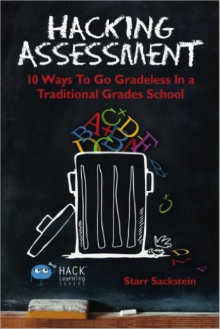Ways to Go Gradeless in a School That Grades
Hacking Assessment: 10 Ways to Go Gradeless in a Traditional Grades School
By Starr Sackstein
(Times 10 Publications/Hack Learning, 2015 – Learn more)

When I have conversations with friends or family about teaching, I often hear myself discussing what it would be like if I could run my classroom exactly as I wanted to.
There are many wonderful approaches and strategies I’d like to try. One of these is to discontinue grading and instead just have conversations with students about what they are learning. I have always ended that thought with, “But of course that can’t really happen.”

The subtitle is important because it points out that this is not a book only for the most extreme or radical schools. Here is a guide for those of us who understand the difficulties caused by grades, but who work in traditional public school systems that mandate grades.
Right from the beginning, the reader should know that Sackstein still assigns grades herself, as required by her high school, at the end of the term. The revolution consists of eliminating the individual assignment grades and then generating a final letter grade collaboratively with her students.
Hacking Assessment is part of the Hack Learning Series, which the editor describes as books presenting a unique, perhaps unexpected, solution to a problem in education. The books are designed to be full of quick and useable advice and therefore do not convey extensive theory or reference research. In short, they are designed to be accessible and actionable tools.
Making the case for going gradeless
The book is divided into ten “Hacks” or chapters, each of which is constructed in a pattern:
- Stating the problem
- “The Hack” or new approach
- A blueprint which lists basic steps in applying the Hack
- Overcoming pushback
The first few chapters discuss the mindset shift needed to go gradeless and the approach needed to get parents, colleagues, and students to accept the idea. The rest of the book gets into specifics, providing overviews on how to develop conversations with students, how to use technology to record data effectively, how to structure the learning, and how to teach students to reflect and to self-evaluate.
The organization is effective and makes it easy to go back for a refresher of a specific aspect.
Although this is a practical book, what I most appreciate from Sackstein is her basic argument in favor of the gradeless model. She makes it clear that increased feedback is the key reason for eliminating grades.
In a gradeless classroom, feedback comes through conferences and written comments. It is clear that emphasizing comments in place of letter grades will give students a much richer basis from which to process their understanding of how well they are doing. Percent correct, nine out of ten, or the good old A,B,C don’t provide the learner much, if any, real information about what is learned.
Gradeless in a graded school
Early on in the text, in just a few quick points, Sackstein identifies several basic problems with grades and then goes on to explain how she went gradeless. Although completely gradeless schools do exist, Sackstein’s school does require grades and Hacking Assessment assumes that the teacher considering her ideas will need to give a final grade.
Sackstein lays out a process in which students spend the term answering polls or surveys, completing other reflective forms, writing self-evaluations and reflections, and then finally, at the end of the term, coming to a conference in which the teacher and student jointly conclude which letter grade best represents the learning achieved.
Without any extended argument, Sackstein quickly convinces the reader of the pedagogical value of making the shift from grades to gradeless. Perhaps because I was already convinced of the premise of the book, the quick points the author makes seem logical and compelling.
The underlying philosophy is to go from merely attaching a letter or number to work, to developing a conversation between teacher and student about the learning process. That shift from just assigning grades to engaging in meaningful discussions and purposeful writing about the learning is the heart of the book.
The match between PBL and going gradeless
As Sackstein describes her classroom, it is clear that she has created a hands-on and project-based culture as opposed to a lecture and test culture. I was pleased to realize that the gradeless concept melds perfectly with this progressive view of teaching that emphasizes active student engagement.
I can begin to see how my own approach to teaching, with an emphasis on writing workshop, literary discussions, and response projects, fits Sackstein’s approach built around feedback and conference based assessment.
The only criticism I have of the book is that there are sections that come across as a little simplified and rushed, but this still works well enough. I understand that (a) the work is not theory-based; (b) I can access other books for more detail, and (c) it’s the nature of the Hack Series to be quick and easy.
Quick and easy works for me. There is sufficient energy and explanation here to get me started in creating my own gradeless classroom.
Authentic learning
Of all the valuable thinking in Hacking Assessment, I am most impressed that the discussion is really about changing the pedagogy—about finding more effective ways to guide student learning. That’s the key reason to cut out grades.
Although the author does not have the space in this get-down-to-business text to extend the argument, the reader can make the conclusion that grades not only limit learning, but actually interfere with learning as students become either turned-off by poor grades or reward-oriented by good ones.
The main reason to read Hacking Assessment is to discover how this approach can serve to engage students much more authentically and to fulfill the ultimate goal of guiding our students to be self-directed learners. Let the conversations begin!
Marek Dzianott teaches reading and writing in a middle school Gifted/Enrichment program in northern Illinois. He enjoys both professional and personal reading and writing. And he really likes playing the piano, even though he’s still just a beginner after years and years of trying to find the time. And he’s jealous (but proud) of his own son who has become skillful at the ukelele in, like, three days. He has been teaching for 25 years and gets a kick out of reading and talking about education.


































